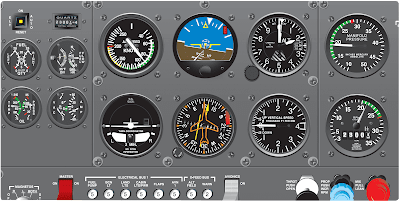Analog Instrument Failure
A warning indicator, or an inconsistency between indications on the attitude indicator and the supporting performance instruments, usually identifies system or instrument failure.
Aircraft control must be maintained while identifying the failed component(s). Expedite the cross-check and include all flight instruments. The problem may be individual instrument failure or a system failure affecting multiple instruments.
One method of identification involves an immediate comparison of the attitude indicator with the rate-of-turn indicator and vertical speed indicator (VSI). Along with providing pitch-and-bank information, this technique compares the static system with the suction or pressure system and the electrical system. Identify the failed component(s) and use the remaining functional instruments to maintain aircraft control.
Attempt to restore the inoperative component(s) by checking the appropriate power source, changing to a backup or alternate system, and resetting the instrument if possible.
Pneumatic System Failure
One possible cause of instrument failure is a loss of the suction or pressure source. This pressure or suction is supplied by a vacuum pump mechanically driven off the engine. Occasionally these pumps fail, leaving the pilot with inoperative attitude and heading indicators.
Figure illustrates inoperative vacuum driven attitude and heading indicators that can fail progressively. As the gyroscopes slow down, they may wander, which, if connected to the autopilot and/or flight director, can cause incorrect movement or erroneous indications. In Figure, the aircraft is actually level and at 2,000 feet mean sea level (MSL). It is not in a turn to the left which the pilot may misinterpret if he or she fails to see the off or failed flags. If that occurs, the pilot may transform a normally benign situation into a hazardous situation. Again, good decisionmaking by the pilot only occurs after a careful analysis of systems.
 |
| Vacuum failure |
Many small aircraft are not equipped with a warning system for vacuum failure; therefore, the pilot should monitor the system’s vacuum/pressure gauge. This can be a hazardous situation with the potential to lead the unsuspecting pilot into a dangerous unusual attitude that would require a partial panel recovery. It is important that pilots practice instrument flight without reference to the attitude and heading indicators in preparation for such a failure.
Pitot/Static System Failure
A pitot or static system failure can also cause erratic and unreliable instrument indications. When a static system problem occurs, it affects the ASI, altimeter, and the VSI. In most aircraft, provisions have been made for the pilot to select an alternate static source. Check the POH/AFM for the location and operation of the alternate static source. In the absence of an alternate static source, in an unpressurized aircraft, the pilot could break the glass on the VSI. The VSI is not required for instrument flight, and breaking the glass provides the altimeter and the ASI a source of static pressure. This procedure could cause additional instrument errors.
